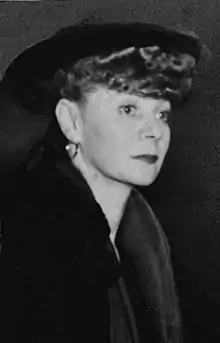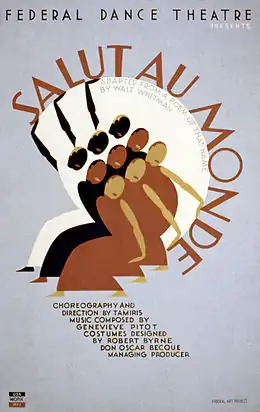Helen Tamiris
Helen Tamiris (born Helen Becker; April 23, 1902 – August 4, 1966)[note 1] was an American choreographer, modern dancer, and teacher.[4]
Helen Tamiris | |
|---|---|
 | |
| Born | Helen Becker April 23, 1902 |
| Died | August 4, 1966 (aged 64) |
| Occupation(s) | Choreographer, dancer |
| Spouse | Daniel Nagrin |
Early life
Tamiris was born Helen Becker in New York City on April 23, 1902, to Isor and Rose (Simonov) Becker. Her parents and brothers Maurice and Charles Becker immigrated from Nizhny Novgorod a decade earlier, fleeing pogroms which were targeted, violent attacks on Jewish people, and settled on the Lower East Side where many other Russian Jewish immigrants lived at that time. Two more children Samuel and Peter, in addition to Helen, were born in New York City. Becker's siblings were similarly artistic. Her oldest brother Maurice became a well-known artist and illustrator; and brothers Samuel and Peter took up sculpting and art collecting, respectively.[5] Rose was institutionalized when Helen was three, leaving the family in the care of Isor.[6]
As a child, Becker was constantly in motion, and her father enrolled her in dance classes at the Henry Street Settlement at the age of eight. The Henry Street Settlement's dance program taught "interpretive dancing," an early form of modern dance taking inspiration from Dalcroze eurhythmics and the work of Isadora Duncan.[7] The early education with the creative freedom of interpretive dance would inform her work as a choreographer for many years.
Becker attended New York City public schools, graduating from Eastern District High School in 1918. According to Pauline Tisch, Becker then studied economics and labor statistics at the Rand School from 1918 to 1920.[5] Her focus on labor statistics preceded her later works in union organizing, a key element of her legacy.
Ballet training and early career
Becker auditioned for the Metropolitan Opera Ballet at age 15, and was accepted, despite her lack of ballet and pointe experience. She trained with the Met for one season, then performed in the corps de ballet for four seasons. Before her final season, she joined the Bracale Opera Company as a soloist on a tour of South America in the summer of 1922.
Upon her return from South America, Becker performed with the Met for another season, while studying with Russian ballet choreographer Michel Fokine. She then danced in a Broadway production of Casanova for which Fokine choreographed the prologue. Dissatisfied with ballet, Becker studied at the Isadora Duncan School, but left after three months.[8] Her autobiography cited the reasons for leaving as "I don't want to be a Duncan dancer - or a ballet dancer - I want to be myself - But what was myself?"[9]
With her independence in mind, Becker worked in commercial dance, including nightclubs and the Music Box Review on Broadway. She took on the stage name of "Tamiris," which was given to her by the Chilean writer Armando Zegri who wrote for a poem for Becker, stating: "Thou art Tamiris, the ruthless queen who banishes all obstacles," a mantra of her career.[10][11]
In October 1927, Tamiris made her premiere as a solo modern dancer, accompanied by composer Louis Horst. A second solo performance in January 1928 included a manifesto in its program, detailing Tamiris' desires to keep her works contemporary, sincere, and uniquely American. This manifesto was possibly in reaction to the works of Tamiris' contemporaries Martha Graham and Angna Enters; they had performed at the same venue weeks after Tamiris' debut, and Tamiris was in disagreement with some of their principles.[12] The second performance included two short pieces set to spirituals, the first of a series that would define her career.[8] Tamiris traveled to Europe in 1928, performing in Berlin, Salzburg, and Paris, and furthering her distinct style.[13][14]
Great Depression and Federal Dance Project

In the early 1930s, Tamiris collaborated with Martha Graham, Doris Humphrey, Charles Weidman, and later Agnes de Mille to form the Dance Repertory Theatre. The company was financially successful, but dissolved in 1932. Many of its members went on to form the Bennington College School of Dance, but Tamiris remained independent of this group. A 2000 analysis argues that Tamiris' exclusion from the Bennington College program was due to either antisemitism or backlash against Tamiris' involvement with leftist politics.[15]
The Great Depression and the programs created to mitigate it, including the Works Progress Administration, had a large impact on Tamiris' work. Tamiris' advocacy led to the expansion of the Federal Dance Project under the WPA, and she later became the director of the Federal Theatre Project.
While working with the FDP, Tamiris simultaneously acknowledged that it was not a full solution to the issue of unemployed dancers. Tamiris wanted dancers to be understood as laborers, due to the significant physical demands of their work, and believed that the difficulties faced by dancers in the workplace were relevant to contemporaneous labor movements.[16]
Much of Tamiris' known work deals with social issues like racism and war. She is best known for her suite of dances, Negro Spirituals, created between 1928 and 1942. Eight pieces of this suite were performed at the Brooklyn Academy of Music in April 1939, in a program shared with Hanya Holm.[17] A contemporaneous piece, How Long Brethren? (1937), was danced to protest songs, and won Dance Magazine's first award for group choreography.[11] The final example of Tamiris' work for the Federal Theatre Project before its closure is Adelante (1939), a critique of the Spanish Civil War.[18]
Later career
Modern dancer and choreographer Daniel Nagrin saw Tamiris' works as early as 1936, and joined her company in 1941. They married in September 1946, and continued to collaborate professionally.[19]
Tamiris choreographed for musical theatre in the 1940s and mid-1950s, insisting on racial integration in her casts. This, along with her earlier union organizing and activism, prompted an FBI investigation and accusations of Communism. Tamiris was listed in Red Channels in 1950, and despite an internal FBI review in 1955 denying her affiliation with the Communist Party, her legacy was likely affected greatly by the blacklisting.[6]
Tamiris won a Tony Award for Best Choreography in Touch and Go (1949). Her other musical theatre choreography includes Annie Get Your Gun (1946), Up in Central Park (1947), Flahooley (1951), Carnival in Flanders (1953), Fanny (1954), and Plain and Fancy (1955).
Death and legacy
Tamiris and Nagrin separated personally and professionally in 1964. Tamiris became a more private figure after her diagnosis with cancer shortly after their separation, and she died on August 5, 1966, at the age of 64[20][11]
Tamiris was not interested in developing a codified technique of her own, unlike her contemporaries. Tamiris' collaborative attitude towards choreography, encouraging her dancers to utilize their "inner action," and her focus on content over form, is argued by contemporary scholars to constitute a distinct style.[21][22][20]
Despite the magnitude of her works, Tamiris' legacy is less known than that of her peers. Washington Post dance critic Alan M. Kriegsman described her as "the great unsung pioneer of American dance."[23] Tamiris' longtime partner Daniel Nagrin attributed Tamiris' lesser-known legacy to her intense social, political, and artistic passion, which he argued frightened her peers; and to Tamiris' use of jazz in her early works, when its legitimacy may have still been in question.[24] Contrastingly, New York Times critic Jack Anderson argued that Tamiris' legacy was marred by personal rivalries among her peers.[25]
Tamiris drafted an autobiography, but did not finish it before her death. A revised version of the draft, annotated by Nagrin, was published by the Society of Dance History Scholars in 1989.[26] The revised draft covers Tamiris' childhood and early career, ending before her 1928 trip to Europe.[27]
See also
Publications
- Tamiris, Helen (1989) [drafted 1939]. Nagrin, Daniel (ed.). "Tamiris in Her Own Voice: Draft of an Autobiography". Studies in Dance History. Pennington, NJ: Society of Dance History Scholars. 1 (1): 1–64. ISSN 1043-7592.
References
Notes
References
- "Helen Tamiris | American dancer and choreographer". Encyclopedia Britannica. 2023-04-20. Retrieved 2023-05-13.
- "Tamiris, Helen, 1905-1966". LC Linked Data Service: Authorities and Vocabularies. Library of Congress. Retrieved 2023-05-13.
- Tamiris 1989, p. 4: "I was born on Madison St. in Manhattan ... it is corroborated by a copy of a birth certificate that I saw for the first time only last week ... on April 23, 1902 of Russian Jewish immigrants."
- Tish, Pauline (1994). "Remembering Helen Tamiris". Dance Chronicle. 17 (3): 327–360. doi:10.1080/01472529408569171. ISSN 0147-2526. JSTOR 1567892. Retrieved 2023-04-20.
- Tish, Pauline (20 March 2009). "Helen Tamris (1902–1966)". Jewish Women: A Comprehensive Historical Encyclopedia. Retrieved November 3, 2020.
- Stabile, Carol A.; Favara, Jeremiah; Strait, Laura. "Tamiris, Helen". The Broadcast 41: Women and the Anti-Communist Blacklist. University of Oregon. Retrieved 2023-04-20.
- McPherson, Elizabeth; Tucker, JoAnne (September 2019). "An Exploration of the Life and Work of Helen Tamiris (1902-1966)" (PDF). Dance Today מחול עכשיו. No. 36. pp. 49–53. ISSN 1565-1568. Archived (PDF) from the original on 2019-09-28.
- McPherson & Tucker 2019, p. 50.
- Tamiris 1989, p. 20.
- Davis, Robert (2010). "Is Mr. Euripides a Communist? The Federal Theatre Project's 1938 'Trojan Incident'". Comparative Drama. 44/45 (Winter 2010/Spring 2011): 467. JSTOR 23238801. Retrieved 23 December 2021.
- "Helen Tamiris, Dancer, is Dead; Choreographer Put a Stress on Social Responsibility". The New York Times. 5 August 1966. p. 24. Retrieved 2008-08-13.
- Tamiris 1989, pp. 39, 56.
- Bailey, Brooke (1994). The remarkable lives of 100 women artists. Holbrook, Mass: Bob Adams. pp. 176–177. ISBN 978-1-55850-360-1. Retrieved 2023-06-16 – via Internet Archive.
- Schlundt, Christena L. (1989). "Tamiris: A Chronicle of Her Dance Career 1927-1955". Studies in Dance History. 1 (1): 65–154. ISSN 1043-7592.
- Foulkes, Julia L. (2000). "Angels "Rewolt!": Jewish Women in Modern Dance in the 1930s". American Jewish History. 88 (2): 233–252. ISSN 0164-0178. JSTOR 23886260.
- Hernandez, Patricia Yvonna (2021). Power Delivered Through Dance: Choreographer Intent in Creating American National Identity 1935-1965 (Thesis). Texas A&M International University. pp. 19–20.
- "Festival of the Dance: Helen Tamiris and Hanya Holm". April 18, 1939. Retrieved 2023-04-20 – via Brooklyn Academy of Music Hamm Archives.
- Martin, John (April 21, 1939). "FEDERAL THEATRE GIVES 'ADELANTE'; Second Dance Production of Season, Spanish Theme, Is Work of Helen Tamiris". The New York Times. ISSN 0362-4331. Retrieved 2023-04-20.
- Nagrin, Daniel (2001). "Helen Tamiris and Her Teaching of Choreography". Choreography And The Specific Image. Pittsburgh: University of Pittsburgh Press. pp. 9–23. ISBN 978-0-8229-4147-7.
- Wawrejko, Diane (October 2009). Re-Visioning Modernism in Modern Dance (PDF). Moving Naturally Conference. University of Surrey.
- Tish 1994, p. 332.
- McPherson & Tucker 2019, p. 52.
- Kriegsman, Alan M. (1991-05-04). "DANCE". Washington Post. ISSN 0190-8286. Retrieved 2023-06-06.
- Roses-Thema, Cynthia (2003). "Interview with Daniel Nagrin" (PDF). Journal for the Anthropological Study of Human Movement. 12 (3): 119.
- Anderson, Jack (1995-08-27). "DANCE VIEW; A Champion of Racial Justice When Little Prevailed". The New York Times. ISSN 0362-4331. Retrieved 2023-06-06.
- Tamiris 1989.
- Tamiris 1989, p. 45.